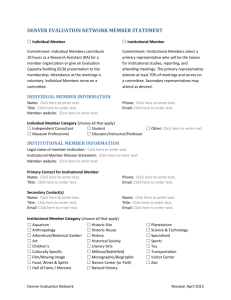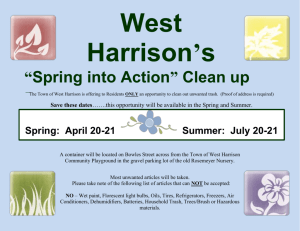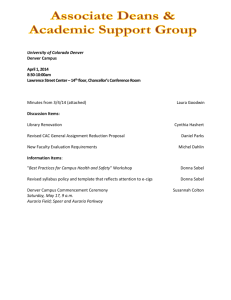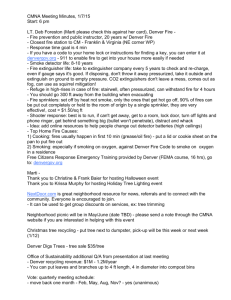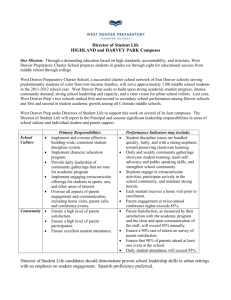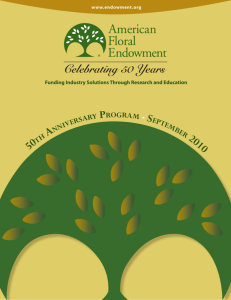Original Template for Home Histories
advertisement
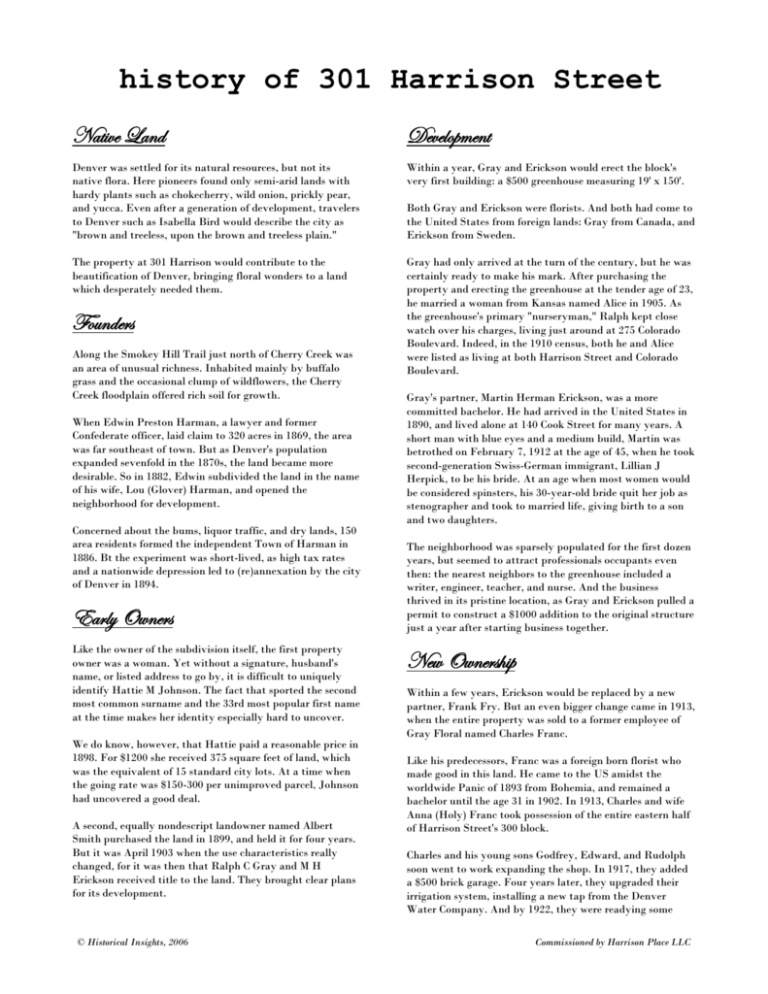
history of 301 Harrison Street Native Land Development Denver was settled for its natural resources, but not its native flora. Here pioneers found only semi-arid lands with hardy plants such as chokecherry, wild onion, prickly pear, and yucca. Even after a generation of development, travelers to Denver such as Isabella Bird would describe the city as "brown and treeless, upon the brown and treeless plain." Within a year, Gray and Erickson would erect the block's very first building: a $500 greenhouse measuring 19' x 150'. The property at 301 Harrison would contribute to the beautification of Denver, bringing floral wonders to a land which desperately needed them. Gray had only arrived at the turn of the century, but he was certainly ready to make his mark. After purchasing the property and erecting the greenhouse at the tender age of 23, he married a woman from Kansas named Alice in 1905. As the greenhouse's primary "nurseryman," Ralph kept close watch over his charges, living just around at 275 Colorado Boulevard. Indeed, in the 1910 census, both he and Alice were listed as living at both Harrison Street and Colorado Boulevard. Founders Along the Smokey Hill Trail just north of Cherry Creek was an area of unusual richness. Inhabited mainly by buffalo grass and the occasional clump of wildflowers, the Cherry Creek floodplain offered rich soil for growth. When Edwin Preston Harman, a lawyer and former Confederate officer, laid claim to 320 acres in 1869, the area was far southeast of town. But as Denver's population expanded sevenfold in the 1870s, the land became more desirable. So in 1882, Edwin subdivided the land in the name of his wife, Lou (Glover) Harman, and opened the neighborhood for development. Concerned about the bums, liquor traffic, and dry lands, 150 area residents formed the independent Town of Harman in 1886. Bt the experiment was short-lived, as high tax rates and a nationwide depression led to (re)annexation by the city of Denver in 1894. Early Owners Like the owner of the subdivision itself, the first property owner was a woman. Yet without a signature, husband's name, or listed address to go by, it is difficult to uniquely identify Hattie M Johnson. The fact that sported the second most common surname and the 33rd most popular first name at the time makes her identity especially hard to uncover. We do know, however, that Hattie paid a reasonable price in 1898. For $1200 she received 375 square feet of land, which was the equivalent of 15 standard city lots. At a time when the going rate was $150-300 per unimproved parcel, Johnson had uncovered a good deal. A second, equally nondescript landowner named Albert Smith purchased the land in 1899, and held it for four years. But it was April 1903 when the use characteristics really changed, for it was then that Ralph C Gray and M H Erickson received title to the land. They brought clear plans for its development. © Historical Insights, 2006 Both Gray and Erickson were florists. And both had come to the United States from foreign lands: Gray from Canada, and Erickson from Sweden. Gray's partner, Martin Herman Erickson, was a more committed bachelor. He had arrived in the United States in 1890, and lived alone at 140 Cook Street for many years. A short man with blue eyes and a medium build, Martin was betrothed on February 7, 1912 at the age of 45, when he took second-generation Swiss-German immigrant, Lillian J Herpick, to be his bride. At an age when most women would be considered spinsters, his 30-year-old bride quit her job as stenographer and took to married life, giving birth to a son and two daughters. The neighborhood was sparsely populated for the first dozen years, but seemed to attract professionals occupants even then: the nearest neighbors to the greenhouse included a writer, engineer, teacher, and nurse. And the business thrived in its pristine location, as Gray and Erickson pulled a permit to construct a $1000 addition to the original structure just a year after starting business together. New Ownership Within a few years, Erickson would be replaced by a new partner, Frank Fry. But an even bigger change came in 1913, when the entire property was sold to a former employee of Gray Floral named Charles Franc. Like his predecessors, Franc was a foreign born florist who made good in this land. He came to the US amidst the worldwide Panic of 1893 from Bohemia, and remained a bachelor until the age 31 in 1902. In 1913, Charles and wife Anna (Holy) Franc took possession of the entire eastern half of Harrison Street's 300 block. Charles and his young sons Godfrey, Edward, and Rudolph soon went to work expanding the shop. In 1917, they added a $500 brick garage. Four years later, they upgraded their irrigation system, installing a new tap from the Denver Water Company. And by 1922, they were readying some Commissioned by Harrison Place LLC major additions, including a new family home at 357 Harrison. Business was booming. In the early 1920s can a rapid fire succession of new building permits. $2000 was spent in repairs to the old greenhouse, $3000 for two new steel and concrete greenhouses measuring 36' x 110', and $2200 for a garage and two new smoke stacks. The family added two more two greenhouses in 1926 for $5000, and another in 1929. Even in the midst of the Great Depression, they were steadily growing, pulling permits for yet another 36' x 117' greenhouse in June 1931. Larger economic and scientific forces were at work. Scientists discovered that carnations grown in Colorado offered superior longevity to those produced elsewhere, which caused an enormous expansion of the state's flower export trade. In 1927, Denver alone boasted 3 million square feet of greenhouses, and area florists directed 80% of their efforts towards states such as Texas and Oklahoma. 10 million carnations were shipped out of Denver in 1935. Not only that, but the city was overtaking the gardenia market throughout the West and developing rare roses such as the Scott Key which were produced only in Denver. Hardy strains of baby's breath, chrysanthemums, and lilies also became staples of the Denver florist's stock and trade. sold to Joseph G & Connie B Whitehouse. As proprietors of Third Avenue Florist, the Whitehouses and later Gordon Callbeck maintained the property's floral tradition into the second half of the twentieth century. As the Cherry Creek Dam and Cherry Creek Shopping Center turned the neighborhood toward commercial markets, Third Avenue Flower Shop and Greenhouse provided a larger showroom and a greater focus upon retail. The modern era can be dated to the early 1970s, when a Dutch family took over this long-established greenhouse business. The Veldkamps started out in 1959 as a small floral shop in the Westland Shopping Center and business soon grew to encompass several other shops. By the 1970s, the Veldkamps were running retail outlets in every Target store (and several Albertson's branches) in Colorado under the name "Veldkamp's Dutch Flower Market." They needed more nurseries, and the space at 3rd and Harrison was a perfect fit. Rebirth Third Incarnation In July 2005, Harrison Place LLC purchased the old Veldkamp Florist space with plans to seed new life in this old space. Where once there were once flowers encompassing every imaginable variety, soon there will be luxury condominiums. A new three story building will spring from the ground, providing residents with mountain views and central access throughout Denver. The business so firmly planted by Franz & Sons was transformed in October 1948, when the greenhouses were Just as the essence of birth lies in fertility, the heart of this new project lies in the rich soil of its florid past. © Historical Insights, 2006 Commissioned by Harrison Place LLC

